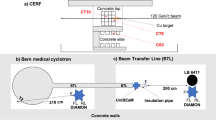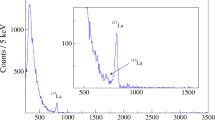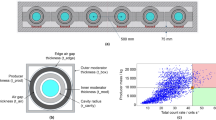Abstract
Emissions of γ-rays from the cold-fusion cells used by Pons and Fleischmann were monitored in Pons' laboratory at the University of Utah by Nal detectors nearly continuously over a five-week period. No evidence of fusion activity was observed above power limits varying between 10−12 and 10−6 W for the known fusion reactions. In addition, neutron-track detectors indicated an integrated upper limit of approximately 1 emitted neutron per second from any of the cold-fusion cells over a period of 67 hours.
This is a preview of subscription content, access via your institution
Access options
Subscribe to this journal
Receive 51 print issues and online access
$199.00 per year
only $3.90 per issue
Buy this article
- Purchase on Springer Link
- Instant access to full article PDF
Prices may be subject to local taxes which are calculated during checkout
Similar content being viewed by others
References
Fleischmann, M., Pons, S. & Hawkins, M. J. electroanalyt. Chem. 261, 301–308 (1989); and erratum, 263, 187–188 (1989).
Petrasso, R. D. et al. Nature 339, 183–185 (1989); and erratum, 339, 264 (1989).
Fleischmann, M., Pons, S. & Hoffman, R. J. Nature 339, 667 (1989).
Petrasso, R. D. et al. Nature 339, 667–669 (1989).
Wolf, K. et al. Proc. Workshop on Cold Fusion Santa Fe, May 23–25, (1989).
Proc. Workshop on Cold Fusion (Santa Fe, May 23–25, (1989).
Zel'dovich, Ya. B. & Gershtein, S. S. Sov. Phys. Usp. 3, 593–623 (1961).
Barkas, W. H. & Berger, M. J. in Studies in Penetration of Charged Particles in Matter 103–172 (Natn. Acad. Sci. Natn. Res. Council Publn 1133, Washington, DC, 1964).
Stelson, P. H. & McGowan, F. K. Phys. Rev. 110, 489–506 (1958).
Fowler, J. L. & Brolley, J. E. Jr Rev. mod. Phys. 28, 103–134 (1956).
Walling, C. & Simons, J. J. phys. Chem. 93, 4693–4696 (1989).
Berger, M. J. & Seltzer, S. M. in Studies in Penetration of Charged Particles in Matter 69–98 (Natn. Acad. Sci. Natn. Res. Council Publn 1133, Washington, DC, 1964).
Fleischer, R. L., Price, P. B. & Walker, R. M. Nuclear Tracks in Solids (University of California Press, Berkeley, 1975).
Hess, W. N., Canfield, E. H. & Lingenfelter, R. E. J. geophys. Res. 66, 665–677 (1961).
Seltzer, S. M. in Monte Carlo Transport of Electrons and Photons (eds Jenkins, T. M., Nelson, W. R. & Rindi, A.) (Plenum, New York, 1988).
Seltzer, S. M. & Berger, M. J. Nucl. Instrum. Meth. B12, 95–134 (1985).
Andersen, H. H. & Ziegier, J. F. Hydrogen Stopping Powers and Ranges in all Elements (Pergamon, New York, 1977).
Author information
Authors and Affiliations
Rights and permissions
About this article
Cite this article
Salamon, M., Wrenn, M., Bergeson, H. et al. Limits on the emission of neutrons, γ-rays, electrons and protons from Pons/Fleischmann electrolytic cells. Nature 344, 401–405 (1990). https://doi.org/10.1038/344401a0
Received:
Accepted:
Issue Date:
DOI: https://doi.org/10.1038/344401a0
This article is cited by
-
Martin Fleischmann (1927–2012)
Nature (2012)
-
Concerning the detection of neutrons and γ-rays from cells containing palladium cathodes polarized in heavy water
Il Nuovo Cimento A (1992)
-
A cold fusion chronology
Journal of Radioanalytical and Nuclear Chemistry Articles (1991)
Comments
By submitting a comment you agree to abide by our Terms and Community Guidelines. If you find something abusive or that does not comply with our terms or guidelines please flag it as inappropriate.



